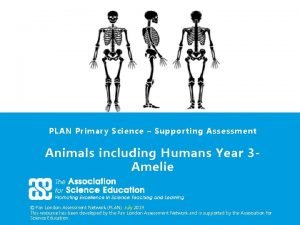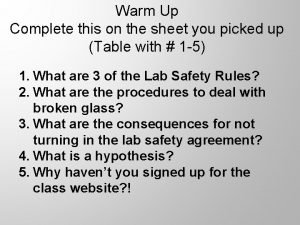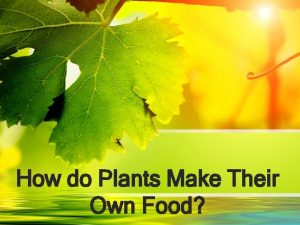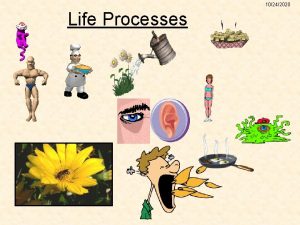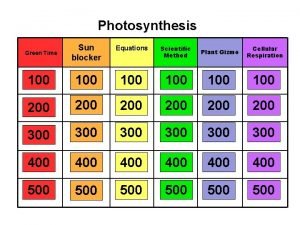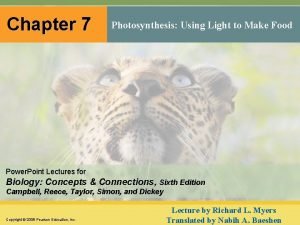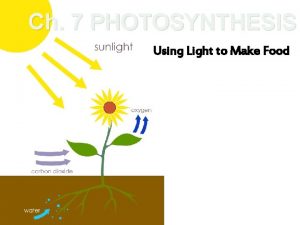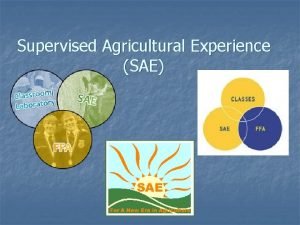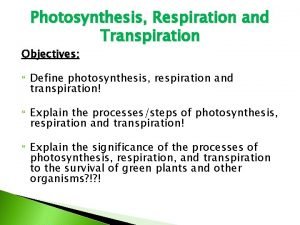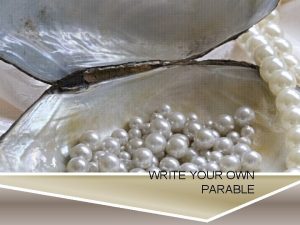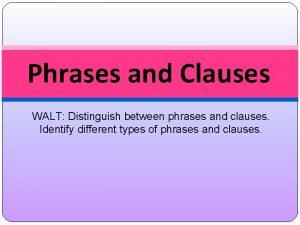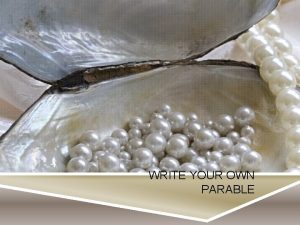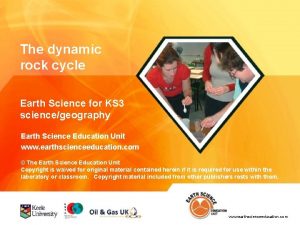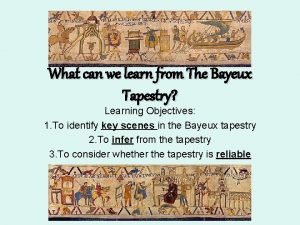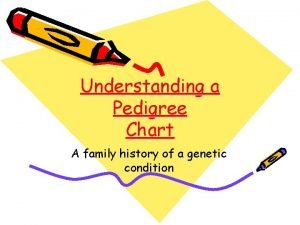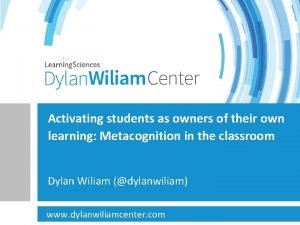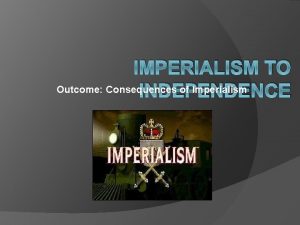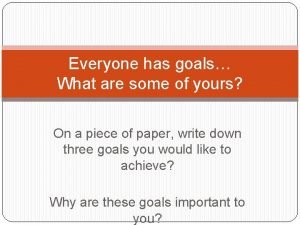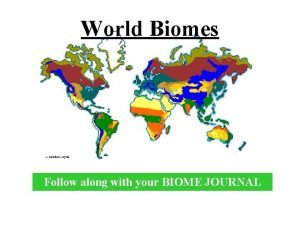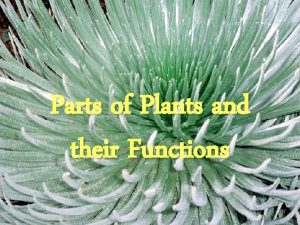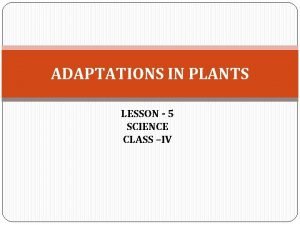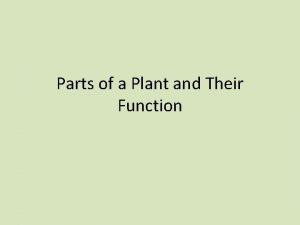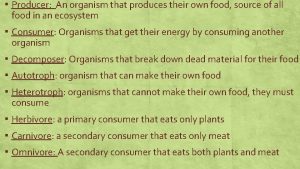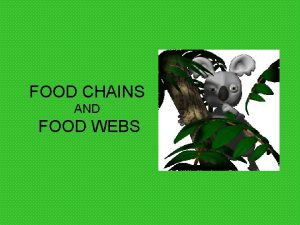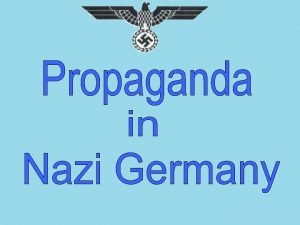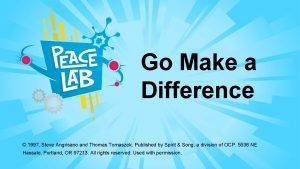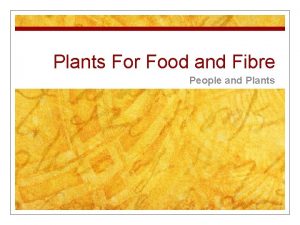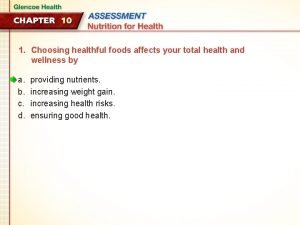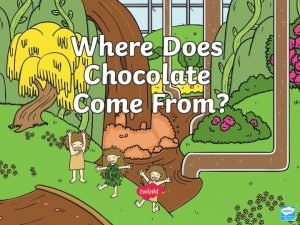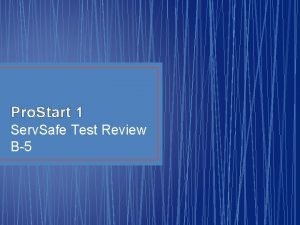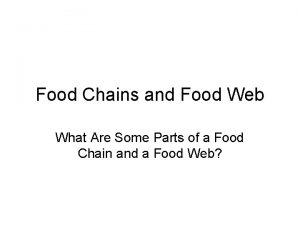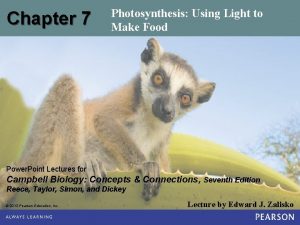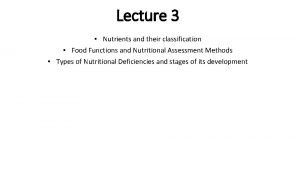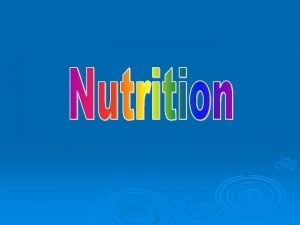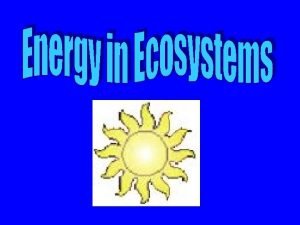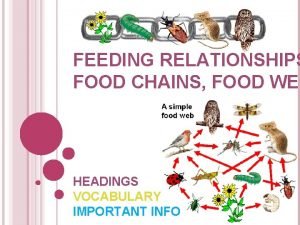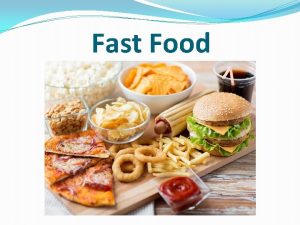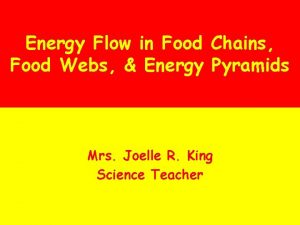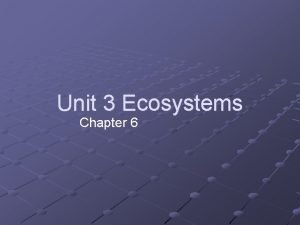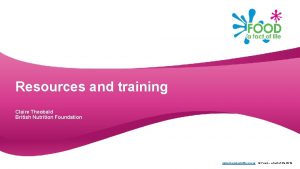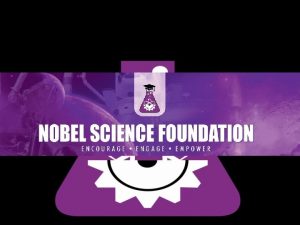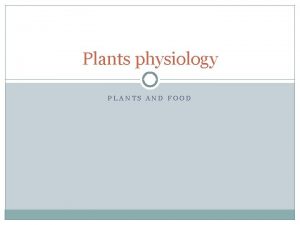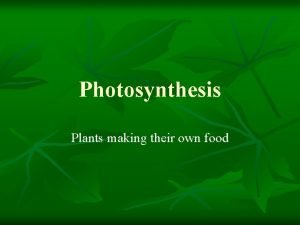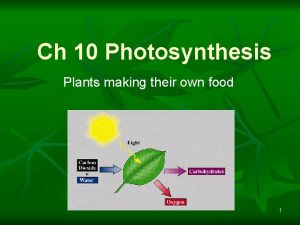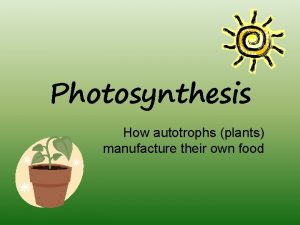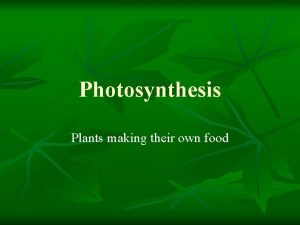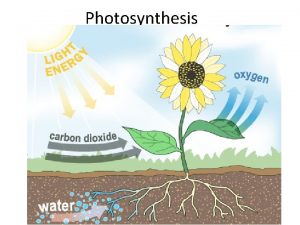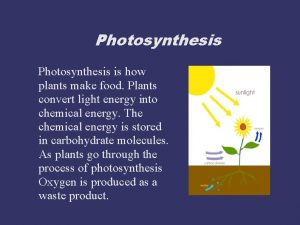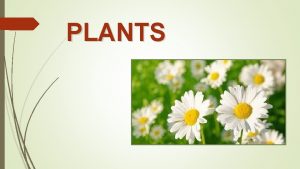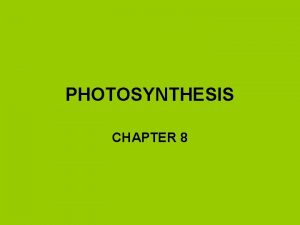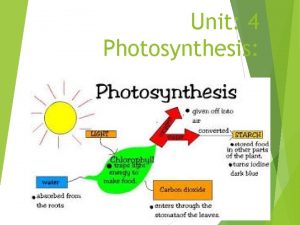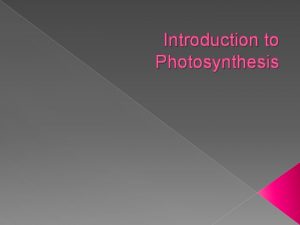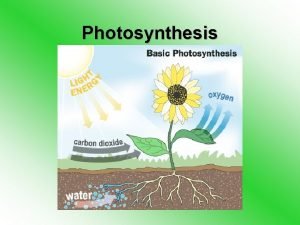Photosynthesis How plants make their own food Aidhm







































































- Slides: 71

Photosynthesis How plants make their own food

Aidhm

Photosynthesis Song

Question Time From your knowledge of JC Science 1. What is photosynthesis 2. What things are needed for photosynthesis 3. What type of organisms photosynthesise 4. What is produced in photosynthesis 5. Why is photosynthesis necessary? (3 reasons)

Photosynthesis How green plants make their own food. Occurs in chloroplasts. n n Animals get their food from plants It produces oxygen needed for respiration Responsible forming fossil fuels Removes carbon dioxide from the air

Can you write out the word equation of photosynthesis oxygen Energy from sunlight, with chlorophyll as a catalyst, is used to combine CO 2 and H 2 O to form glucose and release O 2 chlorophyll glucose r te wa www. juniorscience. ie Carbon dioxide

Photosynthesis word equation Chlorophyll Carbon Dioxide + Water Reactants www. juniorscience. ie Light Glucose + Oxygen Products

Balanced Equation for Photosynthesis

An overview of photosynthesis

Using your book to answer the following questions 1. Light is absorbed What part of the chloroplast traps light? Where is the energy passed to? n n 2. Water is split • • • What type of energy is used to split the water What does a hydrogen split up into What do 2 water molecules split up into? 3. What happens to the products of the water molecules? 4. How is glucose formed and what is its chemical formula?

Main stages in Photosynthesis 1. 2. 3. 4. 5. Light is absorbed Water is split Products are produced (4 protons, 4 electrons and oxygen) Light energises electrons Glucose is formed

Water is Split • Light energy is used to split water • A hydrogen splits up into a proton, H+ (also called a hydrogen ion) and an electron (e-) • 2 water molecules split up into four protons, four hydrogens and oxygen

2 H 2 O 4 H+ and 4 e- and O 2 H+ H+ ee- O 2

What happens to these Products? 1. 2. 3. The electrons are passed to chlorophyll, to replace the high energy electrons that leave chlorophyll The protons are stored in a proton pool for later use The oxygen may pass out of the leaf into the atmosphere or else used for plant respiration

Light is Absorbed Also trapped by chlorophyll (found in chloroplasts) n Passed onto electrons in chlorophyll to form high energy electrons n

Glucose is formed n The high energy electrons along with protons from the proton pool are combined with carbon dioxide to form glucose (C 6 H 12 O 6 )

Sources of light for plants n n n Sunlight Artificial light (light bulb) is often used in greenhouses Increasing light can increase growth up to a certain saturation point where no more light can be absorbed and photosynthesis will level off

Sources of carbon dioxide for plants n n 2 sources of carbon dioxide 1. External: from the atmosphere (combustion) 2. Internal: from their own cellular respiration Sometimes artificial sources of carbon dioxide are used to stimulate growth eg. burning gas in a green house

Sources of water for plants n n From the soil by the roots of plants by osmosis This water passes up the stem (due to root pressure and cohesion tension –Dixon and Joly) and is used for photosynthesis

Increasing photosynthesis rate 1. n Increase light: Artificial light (light bulb) is often used in greenhouses. Increasing light can increase growth up to a certain saturation point where no more light can be absorbed and photosynthesis will level off Increase carbon dioxide: Artificial sources of carbon dioxide are used to stimulate growth eg. burning gas in a green house

Learning Check

4. 7 (a) To investigate the influence of light intensity on the rate of photosynthesis

Step 1 Elodea is used because it easier to measure the rate of photosynthesis Cut the stem of the elodea at an angle. Remove several leaves from the cut end of the stem.

Step 2 Sodium bicarbonate allows for a constant concentration of carbon dioxide during the experiment Drop the elodea, stem up, into a test tube of water saturated with sodium bicarbonate.

Step 3 A water bath keeps the temperature constant Place the tube, containing the elodea into a water bath at 25°C.

Step 4 The amount of bubbles a measure of the rate of photosynthesis Switch on the light source and place the water bath containing the elodea 1 m from the lamp. Wait 5 minutes.

Step 5 Observe bubbles being released from the cut end of the stem. Count and record the number of bubbles for 1 minute. Repeat twice more. Calculate the average bubbles per minute. released per minute. .

Step 6 Repeat the experiment, varying the distance (80 cm, 60 cm, 40 cm and 20 cm) between the water bath and the lamp.

Table of results: Distance from light source (cm) Light Intensity or 1/ 2 d (No. of bubbles/ minute) Average Trial 1 Trial 2 Trial 3

Step 7 Plot a graph of light intensity against average no. of bubbles/minute.

Precaution Allow time before counting the bubbles because the plant needs time to adjust

Expected Results

Can you….

END

Photosynthesis Higher Level

Aidhm Explain the role of ATP n Explain the production of ATP from ADP n Explain the role of NADP+ in trapping & transferring electrons & H ions. n Explain the Light Stage/Dark Stage n State the two-pathway system of electron carriage. 1. Direct to chlorophyll 2. Trapped by NADP+ n

2 stages of Photosynthesis Light Stage Dark Stage

First Stage: Light Stage or Light Dependent Stage n n In the chloroplast. Dependent on light Light energy energises electrons along 2 possible paths. Very fast, no enzymes needed

Overview of Light Dependent Stage: Pathway 1 Revision bk pg 31

Light Stage (HL): Pathway 1 1. Light is absorbed n Chloroplasts contain a number of pigments, including chlorophyll. These absorb different colours of light except for green. 2. Light energy is passed n from one pigment to the next, until it reaches the reaction centre chlorophyll

n High energy electrons leave the reaction centre chlorophyll and are passed on from one electron carrier to the next.

ADP: Adenosine Diphosphate • Found in cells of all organisms • Low energy molecule (like an empty delivery van)

ATP: Adenosine Triphosphate Phosphorylation: when phosphate is added to a molecule ADP + energy + P ATP + water n n Extra phosphate bound Rich in energy and stores this energy carrying it around in the cell (like a delivery van full of cargo)

Pathway 1

n n n As electrons pass from one carrier to the next, they loose a bit of energy. This energy combines with a molecule of ADP and P to form the high energy ATP The electrons return back to chlorophyll Cyclic Photophosphorylation: electrons that leave, turn ADP into ATP and return back to chlorophyll.

Learning Check 1. 2. 3. 4. 6. 7. 8. 9. 10. Where does the light stage occur? Why is it called the light stage? What absorbs the light energy? How many possible pathways can the electron be passed on? Where does the electron go to from the chlorophyll in pathway 1? What happens to the electron as it is moved around? What is phosphorylation? Why is this pathway called cyclic phosphorylation? What are the end products of pathway 1?

Light stage: Pathway 2

2 H 2 O 4 H+ and 4 e- and O 2 H+ H+ ee- O 2

+ NADP : Nicotinamide Adenine Dinucleotide Phosphate

NADPH NADP+ + 2 electrons + H+ NADPH energy NADP+ is a low energy molecule involved in photosynthesis NADP+ can combine with 2 high energy electrons and a proton to form NADPH is a very high energy molecule NADP+ is reduced to NADPH is used to form glucose in photosynthesis

Overview of Light Dependent Stage: Pathway 2

Light Stage (HL): Pathway 2 n n Sometimes 2 high energy electrons are passed from chlorophyll to the electron acceptor and then along another series of electron acceptors They lose energy as they pass from electron acceptor to electron acceptor and this energy is used to make more ATP

Electron Pathway 2 (HL) n n Eventually the 2 electrons are passed to combine with NADP+ to form NADPThe chlorophyll molecule is now short of electrons and gains more from the splitting of water 2 water molecules split up into four protons, four hydrogens and oxygen Photolysis: The splitting of water by light

n n The protons that were stored in the proton pool are attracted to NADP- and combine with it to form NADPH Because the electrons start at a chlorophyll and finish at NADPH and form ATP on their way this pathway is known as Non cyclic photophosphorylation

Light stage: Pathway 2

Light stage (HL) Light Stage Phosphorylation Making ATP Photolysis Splitting water

End Products of the Light Stage (HL) • 1. 2. 3. There are 3 end products of the light stage ATP this will provide energy for the dark stage NADPH this will provide protons + energised electrons for the dark stage Oxygen is made when water is split

End Products of the Light Stage (HL)

Learning Check

Photosynthesis Higher Level

Learning Check 1. 2. 3. 4. 5. What is the product of pathway 1 What are the products of pathway 2 Describe what happens to each of these products? Why do you think the dark stage is given this name? This stage is controlled by enzymes. Is this stage effected by heat?

Overview of Dark Stage or Light Independent Stage (HL) n Controlled by enzymes and therefore can be affected by temperature

Dark Stage (HL) n n Carbon dioxide from the air enters the chloroplast NADPH (from the light stage) gives up a proton and electrons to CO 2. This makes glucose NADP+ returns to be used in the light stage reactions

Dark Stage (HL) n n Making glucose needs energy. It uses energy got from breaking down ATP ADP + P

O. I. L. R. I. G. Oxidation is loss of electrons n Reduction is gain of electrons n n Carbon Dioxide is reduced to glucose

Learning Check

Light Stage in Summary n n Light dependent. It involves the energising of electrons and their passage along 2 pathways n Pathway 1: Light energising electrons from chlorophyll are passed onto electron carriers and return to chlorophyll. In this process, they loose energy to form ATP n Pathway 2: Two electrons go to NADP+ to form NADP-. Energy is lost to form ATP. Photolysis of water occurs, 2 electrons go chlorophyll and protons got to NADP- to form NADPH Products formed n n n ATP – for dark stage NADPH – for dark stage O 2 – for respiration or is released

Dark Stage in Summary n n Light is not required. Carbon dioxide is needed. It supplies the carbon to make glucose. Two products from light stage n n n NADPH supplies H+ and electrons ATP supplies energy Main product is glucose (monosaccharide)

Energy and Electron Carriers Summary n ATP: n n provides energy Reduces carbon dioxide Used to make glucose NADP+: n n Accepts electrons Is a H+ carrier Used for dark stage Used to make glucose

Photosynthesis Chloroplast Split Water NADPH Thylakoids Chlorophyll Dark Stage Stoma CO 2 + 6 H 2 O Phosphorylation Autotroph Horticulture Protons Light Stage Oxygen Sunlight Hydrogen Electrons C 6 H 12 O 6 + 6 O 2

Can you….
 Products of photosynthesis
Products of photosynthesis Green plants make their own food by photosynthesis
Green plants make their own food by photosynthesis Animals can make their own food
Animals can make their own food Animals can make their own food
Animals can make their own food Organisms that make their own food
Organisms that make their own food Chloroplast function
Chloroplast function What is the process?
What is the process? The food that plants produce during photosynthesis is
The food that plants produce during photosynthesis is The process of photosynthesis
The process of photosynthesis Is photosynthesis a redox reaction
Is photosynthesis a redox reaction The process of photosynthesis step by step
The process of photosynthesis step by step Analytical sae examples
Analytical sae examples Define photosynthesis
Define photosynthesis Nonvascular plant
Nonvascular plant Non vascular vs vascular plants
Non vascular vs vascular plants Non flowering plants classification
Non flowering plants classification Photosynthesis equation
Photosynthesis equation Unit 2 food food food
Unit 2 food food food Sequence of food chain
Sequence of food chain How to write a modern parable
How to write a modern parable Does a subordinate clause make sense on its own
Does a subordinate clause make sense on its own Write your own parable
Write your own parable Make your own folds and faults
Make your own folds and faults Writing
Writing What can we learn from the bayeux tapestry
What can we learn from the bayeux tapestry Make your own pedigree
Make your own pedigree Activating students as owners of their own learning
Activating students as owners of their own learning Why did gandhi encourage indians to weave their own cloth?
Why did gandhi encourage indians to weave their own cloth? Everyone has their own goals
Everyone has their own goals British traditions and customs
British traditions and customs Photosynthesis and food chain
Photosynthesis and food chain Nitrogen rich fertilizer
Nitrogen rich fertilizer Plant adaptations in temperate forest
Plant adaptations in temperate forest Function of leaves in plants
Function of leaves in plants What are the 6 main parts of a plant
What are the 6 main parts of a plant Adaptation in plants class 7
Adaptation in plants class 7 4 parts of plants
4 parts of plants An organism that produces its own food
An organism that produces its own food Food chain begins with
Food chain begins with Make the lie big make it simple
Make the lie big make it simple Steve angrisano go make a difference
Steve angrisano go make a difference Make the lie big make it simple
Make the lie big make it simple What ishorticulture
What ishorticulture Seeds travel
Seeds travel Plants for food and fibre
Plants for food and fibre Two households both alike
Two households both alike Pests can cause which two types of contamination
Pests can cause which two types of contamination Your body uses carbohydrates by breaking them down into
Your body uses carbohydrates by breaking them down into Make delicious food
Make delicious food Surf safe test
Surf safe test Food web with earthworm
Food web with earthworm Using light to make food
Using light to make food Funtions of food
Funtions of food How does a euglena eat
How does a euglena eat Hamster cheek pouch
Hamster cheek pouch What did the northwest coast eat
What did the northwest coast eat When should hand antiseptics be used?
When should hand antiseptics be used? Food scientist measure food energy in
Food scientist measure food energy in Which food is tcs food
Which food is tcs food Which food is a tcs food
Which food is a tcs food Quantifiers for food
Quantifiers for food Food web vs food chain
Food web vs food chain Food handlers can contaminate food when they:
Food handlers can contaminate food when they: Fast food nation summary
Fast food nation summary Consists of many overlapping food chains in an ecosystem
Consists of many overlapping food chains in an ecosystem Food chains are interconnecting food webs
Food chains are interconnecting food webs Food chain
Food chain Fast food can be defined as any food that contributes
Fast food can be defined as any food that contributes Easy food web
Easy food web A consumer that primarily eats one specific organism
A consumer that primarily eats one specific organism Difference between food chain and food web
Difference between food chain and food web Explorefood.foodafactoflife.org.uk
Explorefood.foodafactoflife.org.uk



